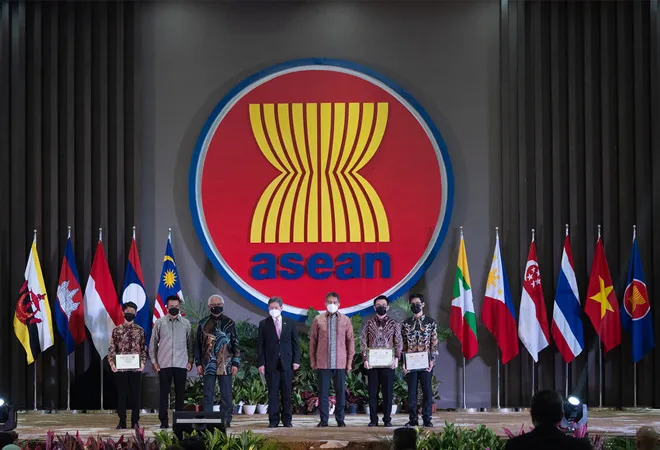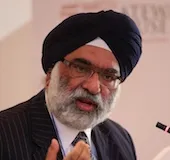-
CENTRES
Progammes & Centres
Location
As the great power rivalry ratchets up, ASEAN should be aware that a multipolar world is more conducive to its model of cooperation.

On 8 August 2022, ASEAN celebrated its 55th anniversary, which coincides with the 77th anniversary of the atomic bombings of Nagasaki. This juxtaposes the pacific, liberal construct that ASEAN tries to build with the sheer power matrix that the Nagasaki bombings manifested. The ASEAN Ministerial Meeting (AMM) on 3 August 2022 marked its anniversary with relative ease. Cambodia as chair restored credibility since it was under its chairmanship in 2012 that ASEAN saw no agreement at the AMM.
ASEAN deserves praise for having manoeuvred through the dynamic changes in the international order since its inception. The ASEAN grouping was created in 1967 when the Vietnam War was at its peak. The Philippines and Thailand, ASEAN charter members were United States (US) allies through SEATO. They were apprehensive about the spread of communism and wanted to develop without being distracted by security concerns. They externalised their security largely to a US umbrella and built for themselves a region which could seek its social, cultural, and economic development.
ASEAN is in an important focal position in the Indo-Pacific as the entire contention over the South China Sea washes up on its shores.
In 1984, Brunei post-independence joined the ASEAN five. In 1989, ASEAN was somewhat challenged by the emergence of the Asia Pacific Economic Cooperation (APEC). Though seven ASEAN countries are its members, it was not an ASEAN-centric body. ASEAN realised that security often played a detrimental role, affecting its objectives. Therefore, the first ASEAN-centric body with members from outside was established in 1994 when the ASEAN Regional Forum was formed. This remains the largest of the ASEAN-centric bodies, with 27 members. It is somewhat unwieldy and meets only at the level of foreign ministers. Following the creation of the ARF, in the next five years, Vietnam, Laos, Myanmar, and Cambodia joined ASEAN. Since 1999, no new country has joined, though Timor-Leste is eagerly waiting in the wings.
ASEAN is in an important focal position in the Indo-Pacific as the entire contention over the South China Sea washes up on its shores. The transformation of a functional Asia-Pacific to a more strategic Indo-Pacific challenges ASEAN.
In 2023, Indonesia, its largest member, will chair the G20, while Thailand will chair the APEC. The liberal functional approach asked ASEAN to periodically review its functioning and seek greater cohesion and efficacy. Among the significant decisions was the creation of the Treaty on Amity and Cooperation 1976, which was among its members and then open to all willing countries. It now has 43 adherents. In 2015, ASEAN created the Economic Community, Political Community, and Socio-cultural Community. Most ASEAN activity and with its partners is conducted through these pillars.
ASEAN engagement with other ASEAN-centric bodies, like the East Asia Summit (EAS) also tries to model itself on these three aspects. The ASEAN secretariat is organised to focus on these through differentiated responsibilities.
Since ASEAN lacked the wherewithal to engage in a power tussle, it devised its way to deal with the emerging China-US rivalry, the Quad, and AUKUS. ASEAN would very much like it if such a rivalry fades away because they would not want to choose sides.
However, over the last decade during which the American imprint on the region became lighter and the Chinese aggressive intent grew, ASEAN faced larger strategic and competitive attitudes of some of its partners. Since ASEAN lacked the wherewithal to engage in a power tussle, it devised its way to deal with the emerging China-US rivalry, the Quad, and AUKUS. ASEAN would very much like it if such a rivalry fades away because they would not want to choose sides. However, ASEAN believes that they can engage China, for instance, for two decades to seek a code of conduct in the South China Sea and not feel the need to seek rival support.
Currently, the grouping faces similar issues like the rest of the world: The challenge of the pandemic, economic recovery, the impact of sanctions on Russia, and the resultant problems of the Ukraine crisis.
ASEAN ministers have set a deadline for the military junta in Naypyitaw to make progress on the implementation of the ASEAN five-point consensus, before the ASEAN-related summits in November. Myanmar has played the ASEAN consensus system down and ASEAN is likely to go beyond a consensus model in its next review
The strong Chinese reaction regarding Taiwan coincided with the 55th ASEAN ministerial meeting and the attendant EAS and ARF meeting. Unsurprisingly, Taiwan overshadowed other aspects of the discussion. It was sufficiently concerned for a separate statement to be issued by the AMM on the cross-strait situation in which they sought peaceful negotiations to avoid miscommunications and miscalculations. The union is acutely aware that just as they were adversely impacted by the Ukraine crisis despite the geographical distance, a crisis in Taiwan can have a remarkable impact on the region which may then become closely aligned to the possible area of hostilities.
Since ASEAN is a functional body, it should perhaps try and avoid being distracted by a bipolar strategy construct which is emerging and look to contribute more effectively to a multipolar economic order.
ASEAN works towards keeping a strategic autonomy which includes keeping silent on things it believes will rile some of its friends. However, as the world drifts towards bipolarity between the US and China, ASEAN should be aware that a multipolar world is more conducive to their model of cooperation, just as it is for India and others. Strategic autonomy has a larger validity in a multipolar world. Since ASEAN is a functional body, it should perhaps try and avoid being distracted by a bipolar strategy construct which is emerging and look to contribute more effectively to a multipolar economic order. By doing this, they can play a significant role.
To handle the uncertainties, the wise people in ASEAN, members of the High-Level Task Force, are seeking an ASEAN Vision beyond 2025. By the end of 2022, the task force will present an idea of the common vision of ASEAN 2025–2035. Some themes that emerged from discussions seek to make the union more relevant to the 670 million people of the ASEAN community. Making ASEAN a people-centred organisation was also emphasised. The ASEAN Committee of Permanent Representatives is working on amendments to the ASEAN Charter as well.
India and ASEAN are also marking the 30th anniversary of their dialogue partnership. This is a significant milestone. The special India–ASEAN Foreign Ministers meeting in June showed considerable cohesiveness between Indian and ASEAN positions. ASEAN is increasing its partnerships and has added the UK as its 11th dialogue partner in 2021 and in 2022, Brazil and the United Arab Emirates (UAE) have been brought in as sectoral partners. ASEAN has Sectoral Dialogue Partnerships with Norway, Switzerland and Türkiye<1>, as well as Development Partnerships with Chile, France, Germany, and Italy.
India and ASEAN can cooperate more closely towards an economic and functional relationship which can deal with all the current issues while trying to keep the increasing strategic polarisation out of the matrix. India’s Act East Policy has balanced the engagement through the three pillars and increased defence economic and cultural engagement substantively. India–ASEAN trade and FDI are both expanding and need not compete with ASEAN’s similar engagement with others particularly Japan, Korea, and China.
Among the most important things to pursue is resilient value chains which India and ASEAN can develop, keeping in view the ASEAN- India Trade in Goods Agreement that is now due for review.
ASEAN should recognise that India is seeking a partnership with them, not a donor relationship. A partnership implies mutual responsibilities. India is a consistent supporter of ASEAN cohesiveness and places faith in its centrality. International dynamics requires ASEAN to do more by itself for its unity and to manifest its centrality.
The recalcitrance of the Myanmar junta to abide by ASEAN advice and the Ukraine crisis have both shown a lack of cohesiveness among members. On these issues, however, the broad-based similarity of view with India is unmistakable.
In November, at the India-ASEAN summit, the likelihood of India being accorded the status of a comprehensive strategic partner is high. This means there is adequate trust within ASEAN for India as a partner and there are enough forums for both to discuss functional and economic collaboration. Among the most important things to pursue is resilient value chains which India and ASEAN can develop, keeping in view the ASEAN- India Trade in Goods Agreement that is now due for review.
Several ASEAN countries have similar problems as India. In this, the role of impact investment to achieve the SDGs could be considered since this is a private sector initiative and works well in triangular situations as well. Of particular interest would be the health sector where public health and covering last mile connectivity for it can be usefully dealt with under such investments. Protection of children is another important area since India and many ASEAN countries have youthful populations and a large number of children. Protecting children and their rights, ensuring their education and health and making them good citizens will be major contributions to the future of the region. These things can be done outside direct government engagement. An India-ASEAN Wise People's Group to complement the High-Level Task Force (HLTF) should look at the next five years on challenges of public health, digital vision, economic and social impact, and achieving the SDGs. It should be convened on a Track 1.5 basis.
Protecting children and their rights, ensuring their education and health and making them good citizens will be major contributions to the future of the region.
The effort should be to leverage non-governmental funds in the correct direction, particularly through several lighthouse projects. This will bring in the vitality of the private sector, the civil society and India's exemplary government programmes which can be an important model for several partners in ASEAN.
<1> The Republic of Türkiye changed its official name from The Republic of Turkey on 26 May 2022.
The views expressed above belong to the author(s). ORF research and analyses now available on Telegram! Click here to access our curated content — blogs, longforms and interviews.

Gurjit Singh has served as Indias ambassador to Germany Indonesia Ethiopia ASEAN and the African Union. He is the Chair of CII Task Force on ...
Read More +